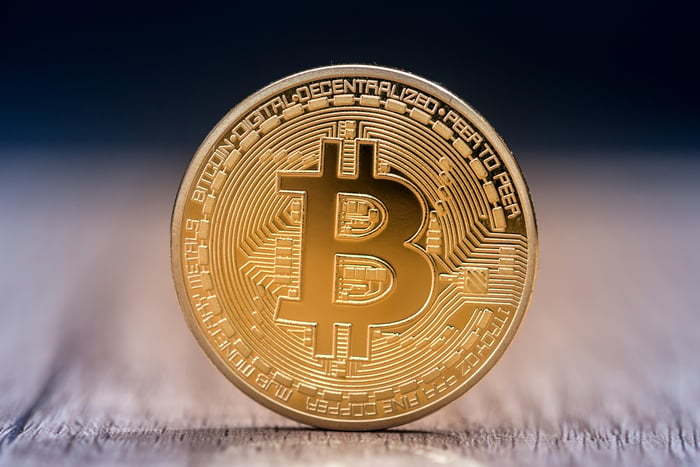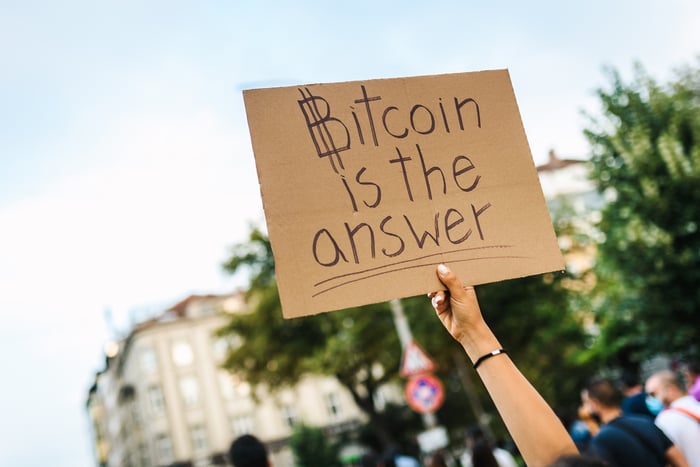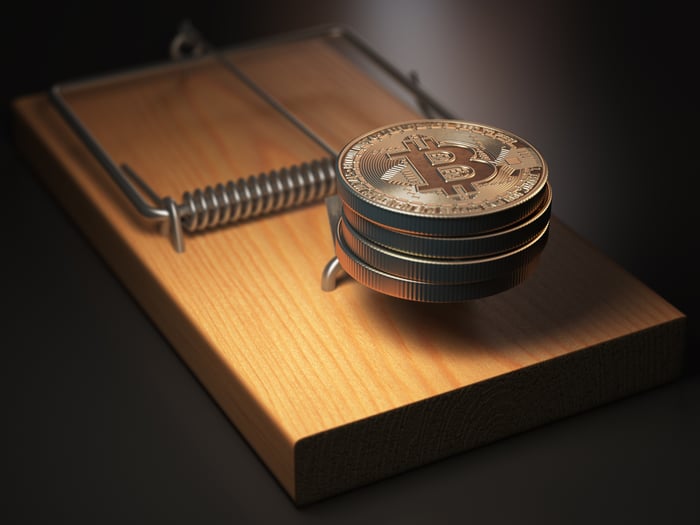Over the very long-term, no asset class has been more successful at making investors richer than the stock market. Although there have been instances where housing, bonds, oil, and other commodities have outperformed equities in the short-term, no other investment vehicles have produced a higher average annual return than stocks.
Over the short-term, it's a completely different story.
Since the coronavirus pandemic trough for equities in March 2020, the broad-based S&P 500 has returned a little over 100%. Meanwhile, the total value of all cryptocurrencies has jumped almost 20-fold, from $141 billion to $2.8 trillion, as of Nov. 12, 2021.

Image source: Getty Images.
Here's how much $100 invested in Bitcoin on its debut day is worth now
Much of the buzz in recent months has gone to the dogs, literally. Meme coin Shiba Inu (SHIB -1.35%) has galloped higher by more than 10,600,000% since its debut on Aug. 1, 2020. Dogecoin, which also derives its inspiration from the Japanese Shiba Inu dog breed, gained more than 27,000% in a six-month stretch between early November 2020 and early May 2021.
But potentially lost in this mix is how insane the returns have been for cryptocurrency blue chip Bitcoin (BTC 0.46%).
Bitcoin first made its debut for trading at the beginning of July 2010 at a price of $0.0008 per token. That's just eight-hundredths of a penny. If we make the hypothetical assumption that there were no transaction fees, a $100 investment on its debut day could have purchased 125,000 Bitcoin.
As of late evening on Nov. 12, at the time of this writing, Bitcoin was going for $63,712.34 per token. An initial $100 investment held for a tad over 11 years and four months has gained almost 8,000,000,000% and would now be worth $7,964,042,400. In other words, Forbes would be including you in their annual list of the world's richest people.
To put this into another context, Tesla Motors' CEO Elon Musk is currently the world's richest person, with an estimated net worth of $281.6 billion. If you had the luck, stomach, and wherewithal to invest $3,550 in Bitcoin on Day 1, you'd be the richest person in the world right now.

Image source: Getty Images.
Here's how Bitcoin has returned almost 8,000,000,000% for its investors since July 2010
You might be wondering how any investment gains nearly 8 billion percent in a little over 11 years. The answer boils down to a couple of factors.
Arguably the biggest catalyst for Bitcoin is the perception of its scarcity. Whereas most cryptocurrencies have large maximum coin supplies (e.g., Shiba Inu started out with a max coin supply of 1 quadrillion), Bitcoin caps at a 21 million token supply. Since Bitcoin is mined and the block rewards associated with transaction validation halve every four years, the full 21 million tokens won't be in circulation until sometime around the year 2140.
To build on this point, Bitcoin is often viewed as an inflationary hedge to what's been a free-wheeling Federal Reserve. Since Great Recession, the U.S. central bank's balance sheet has grown immensely, as has the U.S. money supply. The thinking here is that as inflation ticks higher and the true value of U.S. dollars declines, people will flock to Bitcoin, which has an aforementioned fixed supply of 21 million tokens.
There's also clear excitement about Bitcoin's growing real-world utility. For example, El Salvador became the first country to legalize Bitcoin as tender, as of Sept. 7, 2021. Bitcoin is also the most-accepted digital currency among businesses worldwide.
Not surprisingly, the largest cryptocurrency in the world by market cap has the biggest community, by a mile. Over 76 million people around the world, including 46 million in the U.S., have a unique wallet that contains Bitcoin, as of August 2021. Keep in mind these figures are prior to El Salvador making Bitcoin legal tender.
Lastly, there's continued excitement about future upgrades that'll improve the network and, hopefully, increase adoption. For instance, the long-awaited Taproot upgrade occurred this past weekend. Taproot will boost Bitcoin's privacy, allow for complex (i.e. smart-contract-based) transactions at a cheaper cost, and combine multi-signatures transactions into one, which'll reduce data stored on the blockchain and help scale the network.

Image source: Getty Images.
Don't be fooled: Bitcoin is no surefire investment
Although Bitcoin has, thus far, been an unstoppable investment that's proved me wrong, there are plenty of reasons to be skeptical about future upside (or even the ability to maintain its existing gains).
To begin with, Bitcoin isn't truly scarce. A physical commodity, such as gold, is limited to what's already been dug up from the ground and what remains to be mined on Earth. In other words, alchemy can't be used to make more gold. This is what true scarcity looks like. With Bitcoin, there is no physical scarcity. Only written code caps its token limit, and changes can be made if consensus is reached. That's not true scarcity -- it's the perception of scarcity.
Another concern is that Bitcoin may still lag a number of popular cryptocurrencies, even with the Taproot upgrade. At the moment, Bitcoin's transactions process much slower than its peers and cost substantially more. If businesses were looking for a blockchain-based use case that would improve existing payment infrastructure, Bitcoin would be way down the list of long-term candidates.
Furthermore, Bitcoin is constantly being battered by dilution. But I'm not talking about token inflation. Rather, I'm speaking to the hundreds of new coins and blockchain projects being introduced on a weekly basis. While Bitcoin has first-mover advantages, it's a first-generation technology that could struggle to compete with third-generation blockchain innovation.
The growing ability to trade Bitcoin presents additional challenges. Although shorting popular digital currencies is possible on many crypto exchanges, short-selling crypto is rare due to its volatility and sometimes sketchy liquidity. For some tokens, this creates something of a buy bias. But with the number of derivative listings for Bitcoin growing, it's providing a means for big money to bet against the world's largest digital currency. In essence, as access to Bitcoin grows, so does the ability to short-sell it.
Lastly, history is pretty clear that investors always overestimate how quickly new technology will be adopted. Every next-big-thing trend since the mid-1990s has gone through a bubble phase and eventually deflated. This doesn't mean blockchain technology won't play a major role at some point in the future. It's simply to point out that the big gains in Bitcoin will likely prove fleeting as the enterprise shift to blockchain takes longer than expected.





